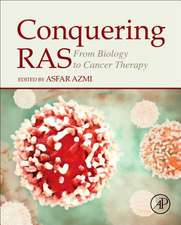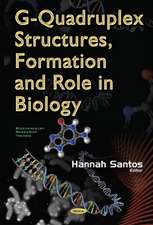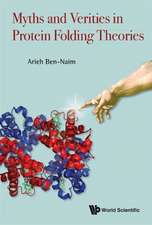Computational Systems Biology: Methods in Molecular Biology, cartea 541
Editat de Jason McDermott, Ram Samudrala, Roger Bumgarner, Kristina Montgomery, Reneé Iretonen Limba Engleză Hardback – apr 2009
| Toate formatele și edițiile | Preț | Express |
|---|---|---|
| Paperback (1) | 683.16 lei 38-45 zile | |
| Humana Press Inc. – 23 aug 2016 | 683.16 lei 38-45 zile | |
| Hardback (1) | 1021.31 lei 3-5 săpt. | |
| Humana Press Inc. – apr 2009 | 1021.31 lei 3-5 săpt. |
Din seria Methods in Molecular Biology
- 9%
 Preț: 791.63 lei
Preț: 791.63 lei - 23%
 Preț: 598.58 lei
Preț: 598.58 lei - 20%
 Preț: 882.98 lei
Preț: 882.98 lei -
 Preț: 252.05 lei
Preț: 252.05 lei - 5%
 Preț: 802.70 lei
Preț: 802.70 lei - 5%
 Preț: 729.61 lei
Preț: 729.61 lei - 5%
 Preț: 731.43 lei
Preț: 731.43 lei - 5%
 Preț: 741.30 lei
Preț: 741.30 lei - 5%
 Preț: 747.16 lei
Preț: 747.16 lei - 15%
 Preț: 663.45 lei
Preț: 663.45 lei - 18%
 Preț: 1025.34 lei
Preț: 1025.34 lei - 5%
 Preț: 734.57 lei
Preț: 734.57 lei - 18%
 Preț: 914.20 lei
Preț: 914.20 lei - 15%
 Preț: 664.61 lei
Preț: 664.61 lei - 15%
 Preț: 654.12 lei
Preț: 654.12 lei - 18%
 Preț: 1414.74 lei
Preț: 1414.74 lei - 5%
 Preț: 742.60 lei
Preț: 742.60 lei - 20%
 Preț: 821.65 lei
Preț: 821.65 lei - 18%
 Preț: 972.30 lei
Preț: 972.30 lei - 15%
 Preț: 660.49 lei
Preț: 660.49 lei - 5%
 Preț: 738.41 lei
Preț: 738.41 lei - 18%
 Preț: 984.92 lei
Preț: 984.92 lei - 5%
 Preț: 733.29 lei
Preț: 733.29 lei -
 Preț: 392.60 lei
Preț: 392.60 lei - 5%
 Preț: 746.26 lei
Preț: 746.26 lei - 18%
 Preț: 962.66 lei
Preț: 962.66 lei - 23%
 Preț: 860.22 lei
Preț: 860.22 lei - 15%
 Preț: 652.64 lei
Preț: 652.64 lei - 5%
 Preț: 1055.50 lei
Preț: 1055.50 lei - 23%
 Preț: 883.87 lei
Preț: 883.87 lei - 19%
 Preț: 491.89 lei
Preț: 491.89 lei - 5%
 Preț: 1038.86 lei
Preț: 1038.86 lei - 5%
 Preț: 524.16 lei
Preț: 524.16 lei - 18%
 Preț: 2122.34 lei
Preț: 2122.34 lei - 5%
 Preț: 1299.23 lei
Preț: 1299.23 lei - 5%
 Preț: 1339.12 lei
Preț: 1339.12 lei - 18%
 Preț: 1390.26 lei
Preț: 1390.26 lei - 18%
 Preț: 1395.63 lei
Preț: 1395.63 lei - 18%
 Preț: 1129.65 lei
Preț: 1129.65 lei - 18%
 Preț: 1408.26 lei
Preț: 1408.26 lei - 18%
 Preț: 1124.92 lei
Preț: 1124.92 lei - 18%
 Preț: 966.27 lei
Preț: 966.27 lei - 5%
 Preț: 1299.99 lei
Preț: 1299.99 lei - 5%
 Preț: 1108.51 lei
Preț: 1108.51 lei - 5%
 Preț: 983.76 lei
Preț: 983.76 lei - 5%
 Preț: 728.16 lei
Preț: 728.16 lei - 18%
 Preț: 1118.62 lei
Preț: 1118.62 lei - 18%
 Preț: 955.25 lei
Preț: 955.25 lei - 5%
 Preț: 1035.62 lei
Preț: 1035.62 lei - 18%
 Preț: 1400.35 lei
Preț: 1400.35 lei
Preț: 1021.31 lei
Preț vechi: 1276.64 lei
-20% Nou
Puncte Express: 1532
Preț estimativ în valută:
195.43€ • 208.98$ • 162.94£
195.43€ • 208.98$ • 162.94£
Carte disponibilă
Livrare economică 28 martie-11 aprilie
Preluare comenzi: 021 569.72.76
Specificații
ISBN-13: 9781588299055
ISBN-10: 1588299058
Pagini: 587
Ilustrații: XVIII, 592 p.
Dimensiuni: 193 x 260 x 33 mm
Greutate: 1.36 kg
Ediția:2009
Editura: Humana Press Inc.
Colecția Humana
Seria Methods in Molecular Biology
Locul publicării:Totowa, NJ, United States
ISBN-10: 1588299058
Pagini: 587
Ilustrații: XVIII, 592 p.
Dimensiuni: 193 x 260 x 33 mm
Greutate: 1.36 kg
Ediția:2009
Editura: Humana Press Inc.
Colecția Humana
Seria Methods in Molecular Biology
Locul publicării:Totowa, NJ, United States
Public țintă
Professional/practitionerCuprins
Network Components.- Identification of cis-Regulatory Elements in Gene Co-expression Networks Using A-GLAM.- Structure-Based Ab Initio Prediction of Transcription Factor–Binding Sites.- Inferring Protein–Protein Interactions from Multiple Protein Domain Combinations.- Prediction of Protein–Protein Interactions: A Study of the Co-evolution Model.- Computational Reconstruction of Protein–Protein Interaction Networks: Algorithms and Issues.- Prediction and Integration of Regulatory and Protein–Protein Interactions.- Detecting Hierarchical Modularity in Biological Networks.- Network Inference.- Methods to Reconstruct and Compare Transcriptional Regulatory Networks.- Learning Global Models of Transcriptional Regulatory Networks from Data.- Inferring Molecular Interactions Pathways from eQTL Data.- Methods for the Inference of Biological Pathways and Networks.- Network Dynamics.- Exploring Pathways from Gene Co-expression to Network Dynamics.- Network Dynamics.- Kinetic Modeling of Biological Systems.- Guidance for Data Collection and Computational Modelling of Regulatory Networks.- Function and Evolutionary Systems Biology.- A Maximum Likelihood Method for Reconstruction of the Evolution of Eukaryotic Gene Structure.- Enzyme Function Prediction with Interpretable Models.- Using Evolutionary Information to Find Specificity-Determining and Co-evolving Residues.- Connecting Protein Interaction Data, Mutations, and Disease Using Bioinformatics.- Effects of Functional Bias on Supervised Learning of a Gene Network Model.- Computational Infrastructure for Systems Biology.- Comparing Algorithms for Clustering of Expression Data: How to Assess Gene Clusters.- The Bioverse API and Web Application.- Computational Representation of Biological Systems.- Biological NetworkInference and Analysis Using SEBINI and CABIN.
Recenzii
From the reviews:“The new volume of the Humana Press ‘Methods in Molecular Biology’ series, entitled ‘Computational Systems Biology,’ consists of 25 chapters authored by 57 specialists in the field. … This book contains a wide collection of methods that … gives a broad review of this fascinating and quickly developing field. … for a computational biologist, it is a fascinating read, a broad and comprehensive resource on the current methods and approaches.” (Borys Wróbel, Acta Biochimica Polonica, Vol. 56, December, 2009)
Textul de pe ultima copertă
The recent confluence of high throughput methodology for biological data gathering, genome-scale sequencing, and computational processing power has driven a reinvention and expansion of the way we identify, infer, model, and store relationships between molecules, pathways, and cells in living organisms. In Computational Systems Biology, expert investigators contribute chapters which bring together biological data and computational and/or mathematical models of the data to aid researchers striving to create a system that provides both predictive and mechanistic information for a model organism. The volume is organized into five major sections involving network components, network inference, network dynamics, function and evolutionary system biology, and computational infrastructure for systems biology. As a volume of the highly successful Methods in Molecular Biology™ series, this work provides the kind of detailed description and implementation advice that is crucial for getting optimal results.
Comprehensive and up-to-date, Computational Systems Biology serves to motivate and inspire all those who wish to develop a complete description of a biological system.
Comprehensive and up-to-date, Computational Systems Biology serves to motivate and inspire all those who wish to develop a complete description of a biological system.
Caracteristici
Presents a broad range of topics related to computational systems biology, including mechanistic modeling, high-throughput data analysis, biological network analysis and data representation and management Provides a number of clearly described, detailed ‘recipes’ for analysis of systems data Supplies a number of alternative approaches to modeling similar types of data Includes supplementary material: sn.pub/extras

















